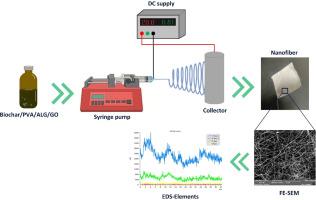Fabrication and characterization of electrospun nanofiber mats composed of biochar, sodium alginate, polyvinyl alcohol, and glyoxal
IF 1.9
Q2 MULTIDISCIPLINARY SCIENCES
引用次数: 0
Abstract
The aim of this study is to synthesize and characterize novel electrospun nanofibers composed of biochar, polyvinyl alcohol (PVA), sodium alginate (ALG), and glyoxal (GO). Biochar, known for its exceptional adsorption capacity, was integrated into the polymer matrix to enhance pollutant removal efficiency. Glyoxal was added to improve the nanofibers' electrical conductivity and mechanical strength. The electrospinning process was optimized to produce uniform, bead-free nanofibers by maintaining a 15 cm needle-to-collector distance, a 20 kV voltage, and a 0.8 mL/h feed rate. Characterization techniques such as FESEM, FTIR, XRD, and BET were employed to analyze the morphology, chemical composition, and surface properties of the nanofibers. The results confirmed the successful incorporation of biochar into the polymer matrix, revealing unique structural and morphological properties in the composite material. The research describes a comprehensive method for synthesizing biochar-loaded nanofibers and reports useful characterization information that could inform future research to optimize nanofiber composition for particular environmental applications.
- •Biochar enhances pollutant adsorption capacity, while glyoxal improves electrical conductivity and mechanical strength. Sodium alginate (ALG) and polyvinyl alcohol (PVA) contribute to biocompatibility and processability, resulting in versatile composite materials.
- •Nanofiber mats were fabricated using varying concentrations of biochar, ALG, and PVA, with an ALG/PVA ratio of 20:80 % and biochar concentrations of 1 % (w/w).
- •Optimal electrospinning conditions included a 15 cm needle-to-collector distance, a 20 kV applied voltage, and a feed rate of 0.8 ml/h, ensuring the production of high-quality nanofibers.

由生物炭、海藻酸钠、聚乙烯醇和乙二醛组成的静电纺纳米纤维垫的制备和表征
本研究的目的是合成和表征由生物炭、聚乙烯醇(PVA)、海藻酸钠(ALG)和乙二醛(GO)组成的新型静电纺丝纳米纤维。生物炭以其优异的吸附能力被整合到聚合物基质中,以提高污染物的去除效率。加入乙二醛可以提高纳米纤维的导电性和机械强度。优化了静电纺丝工艺,通过保持15 cm的针到收集器的距离、20 kV的电压和0.8 mL/h的进料速率,可以生产出均匀、无珠的纳米纤维。采用FESEM、FTIR、XRD和BET等表征技术对纳米纤维的形貌、化学成分和表面性能进行了分析。结果证实了生物炭在聚合物基体中的成功掺入,揭示了复合材料独特的结构和形态特性。该研究描述了一种合成生物炭负载纳米纤维的综合方法,并报告了有用的表征信息,可以为未来的研究提供有用的信息,以优化特定环境应用的纳米纤维成分。•生物炭提高了污染物吸附能力,而乙二醛提高了导电性和机械强度。海藻酸钠(ALG)和聚乙烯醇(PVA)有助于生物相容性和加工性,从而产生多功能复合材料。采用不同浓度的生物炭、ALG和PVA制备纳米纤维垫,ALG/PVA比例为20:80 %,生物炭浓度为1% (w/w)。•最佳静电纺丝条件包括针头到收集器的距离为15厘米,施加电压为20 kV,进料速度为0.8 ml/h,确保生产高质量的纳米纤维。方法名称:静电纺丝。
本文章由计算机程序翻译,如有差异,请以英文原文为准。
求助全文
约1分钟内获得全文
求助全文
来源期刊

MethodsX
Health Professions-Medical Laboratory Technology
CiteScore
3.60
自引率
5.30%
发文量
314
审稿时长
7 weeks
期刊介绍:
 求助内容:
求助内容: 应助结果提醒方式:
应助结果提醒方式:


